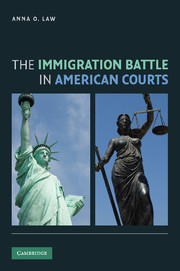Book contents
- Frontmatter
- Contents
- List of Tables and Figures
- Acknowledgments
- 1 Introduction
- 2 How Do We Know What We Know? Data, Methods, and Initial Findings
- 3 The Rise of Two Courts with Differentiated Functions
- 4 Interstitial Policy Making in the U.S. Courts of Appeals
- 5 Institutional Growth and Innovation: The Ninth Circuit Court of Appeals and Immigration
- 6 Continuity Amid Change: The Federal Courts' Commitment to Due Process
- 7 Conclusion
- Appendix A Further Elaboration of Case Selection Methods
- Appendix B Further Elaboration on the Search for Modes of Legal Reasoning
- Appendix C Numerical Codes for Modes of Legal Reasoning
- Appendix D Interview Questions
- Index
- References
6 - Continuity Amid Change: The Federal Courts' Commitment to Due Process
Published online by Cambridge University Press: 04 August 2010
- Frontmatter
- Contents
- List of Tables and Figures
- Acknowledgments
- 1 Introduction
- 2 How Do We Know What We Know? Data, Methods, and Initial Findings
- 3 The Rise of Two Courts with Differentiated Functions
- 4 Interstitial Policy Making in the U.S. Courts of Appeals
- 5 Institutional Growth and Innovation: The Ninth Circuit Court of Appeals and Immigration
- 6 Continuity Amid Change: The Federal Courts' Commitment to Due Process
- 7 Conclusion
- Appendix A Further Elaboration of Case Selection Methods
- Appendix B Further Elaboration on the Search for Modes of Legal Reasoning
- Appendix C Numerical Codes for Modes of Legal Reasoning
- Appendix D Interview Questions
- Index
- References
Summary
Procedural due process is more elemental and less flexible than substantive due process. It yields less to the times, varies less with conditions, and defers much less to legislative judgment. Insofar as it is technical law, it must be a specialized responsibility within the competence of the judiciary on which they do not bend before political branches of the Government, as they should on matters of policy which comprise substantive law.
Justice Jackson, dissenting in Shaugnessy v. United States ex rel. Mezei, U.S. 206, 224 (1953)Two of the recurring modes of legal reasoning that characterize immigration law are plenary power and national sovereignty. Given the expansive ability of these two ideas to provide great leeway for federal action and for correspondingly limited judicial review, what if anything, limits congressional and federal exercise of immigration power over aliens? An examination of the doctrinal development of immigration law reveals that the most significant checks on federal action in immigration have been and continue to be judicial applications of procedural due process protections for aliens. The overwhelming majority of aliens' successful challenges to the exercises of federal power in both the Supreme Court and U.S. Courts of Appeals over immigration have not taken the form of equal protection, substantive due process, or separation of power challenges – it has been due procedural process challenges. Recognizing the form of the judicial limits to federal immigration power is significant in furthering one's understanding of institutional development and evolution.
- Type
- Chapter
- Information
- The Immigration Battle in American Courts , pp. 188 - 230Publisher: Cambridge University PressPrint publication year: 2010
References
- 2
- Cited by



